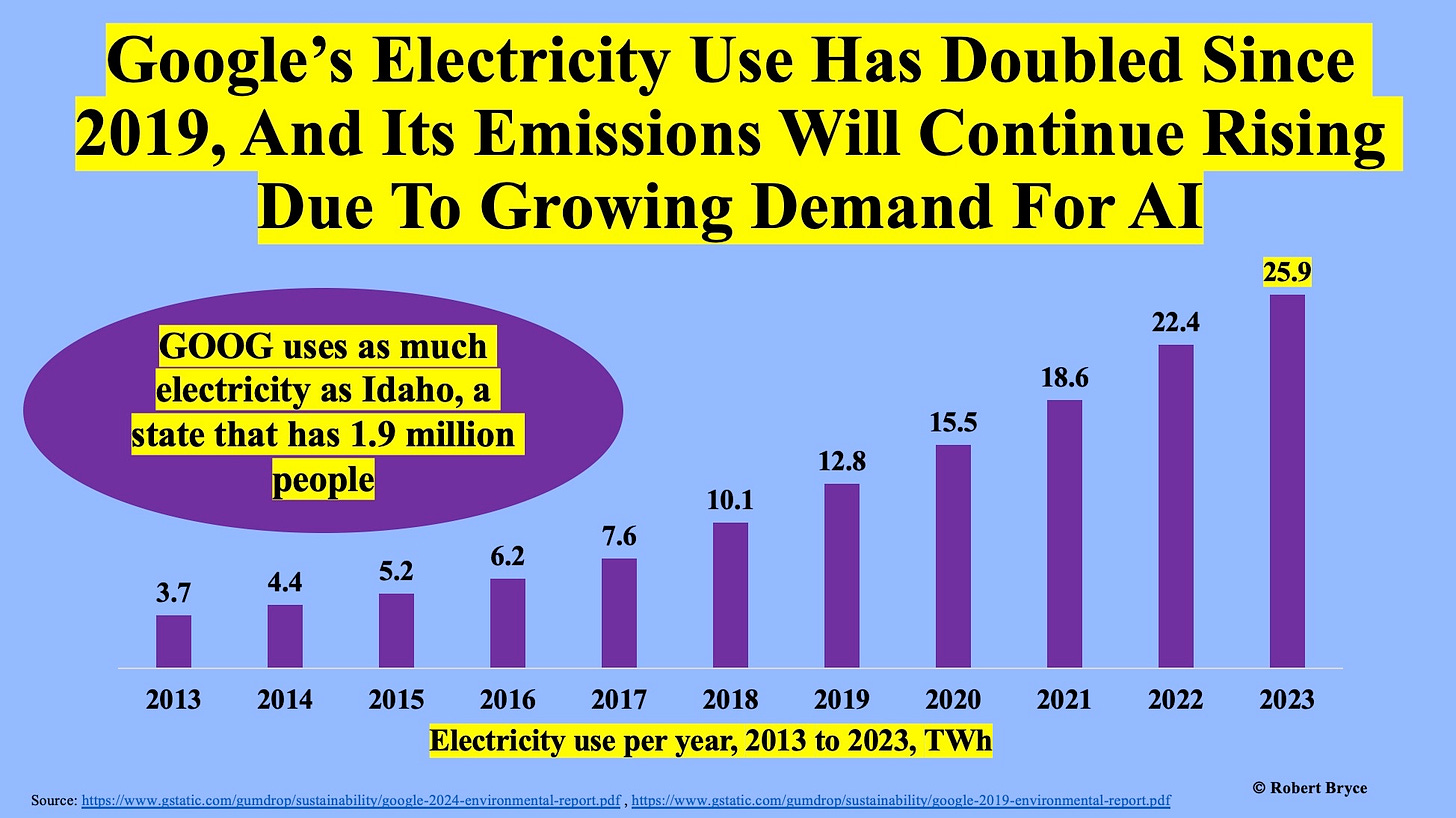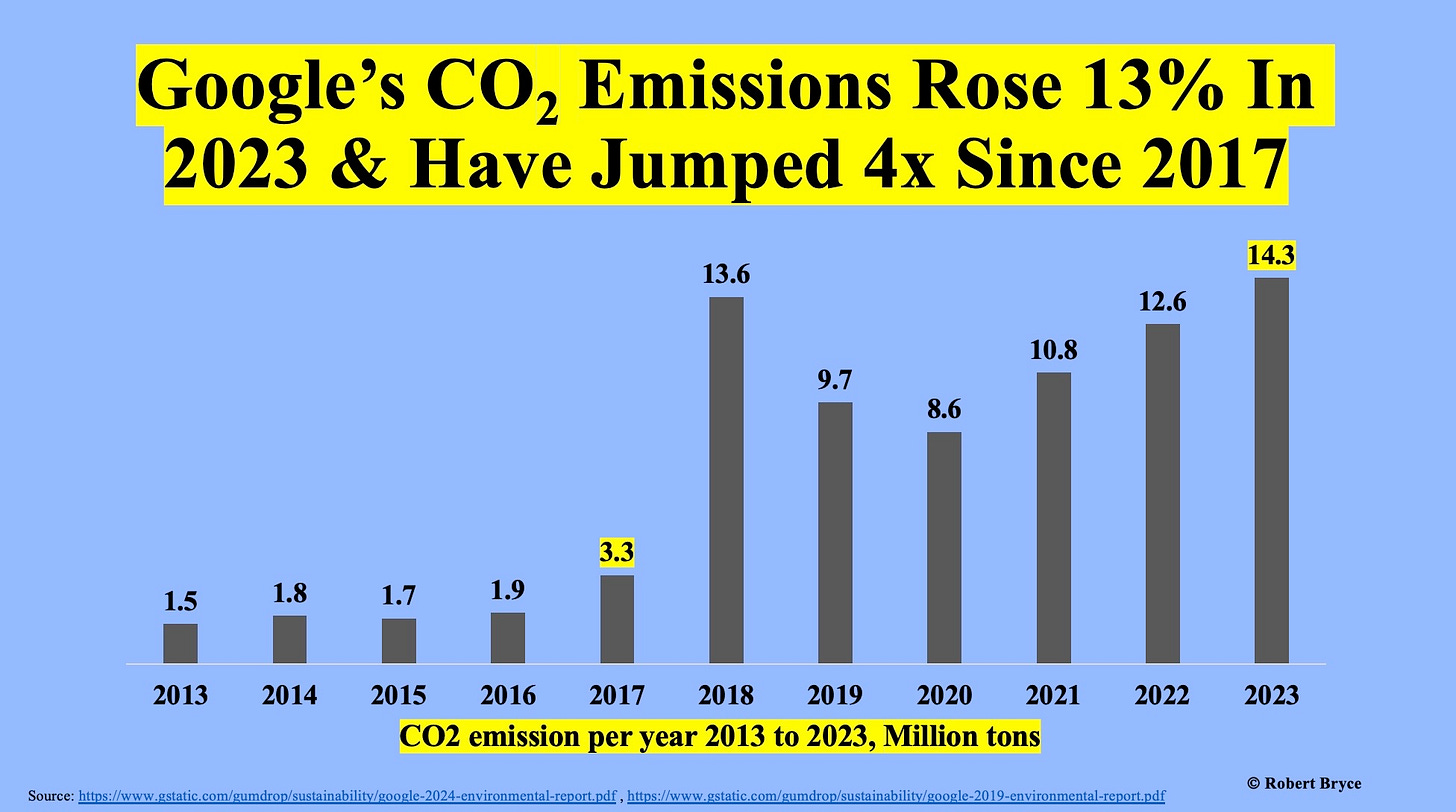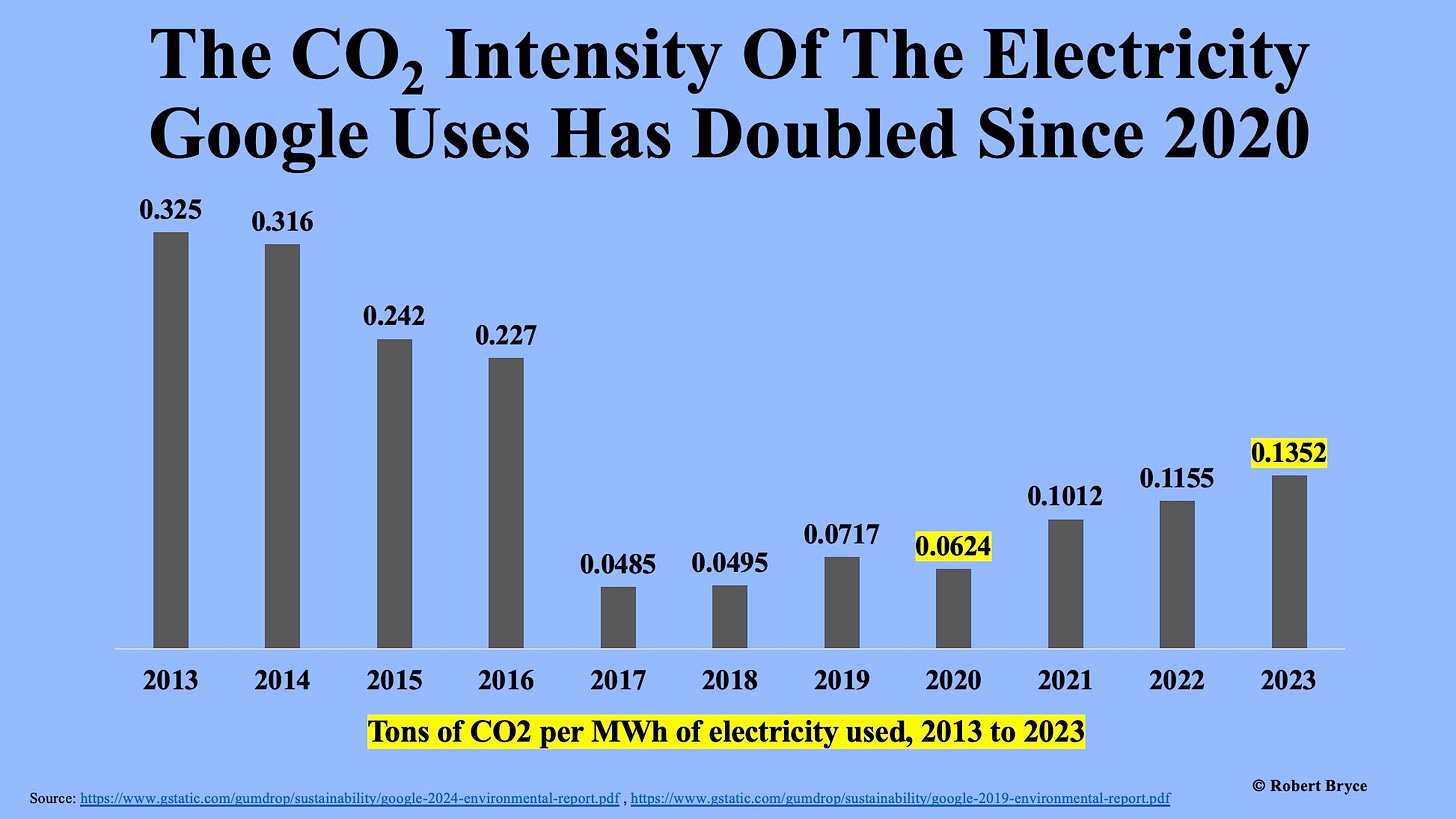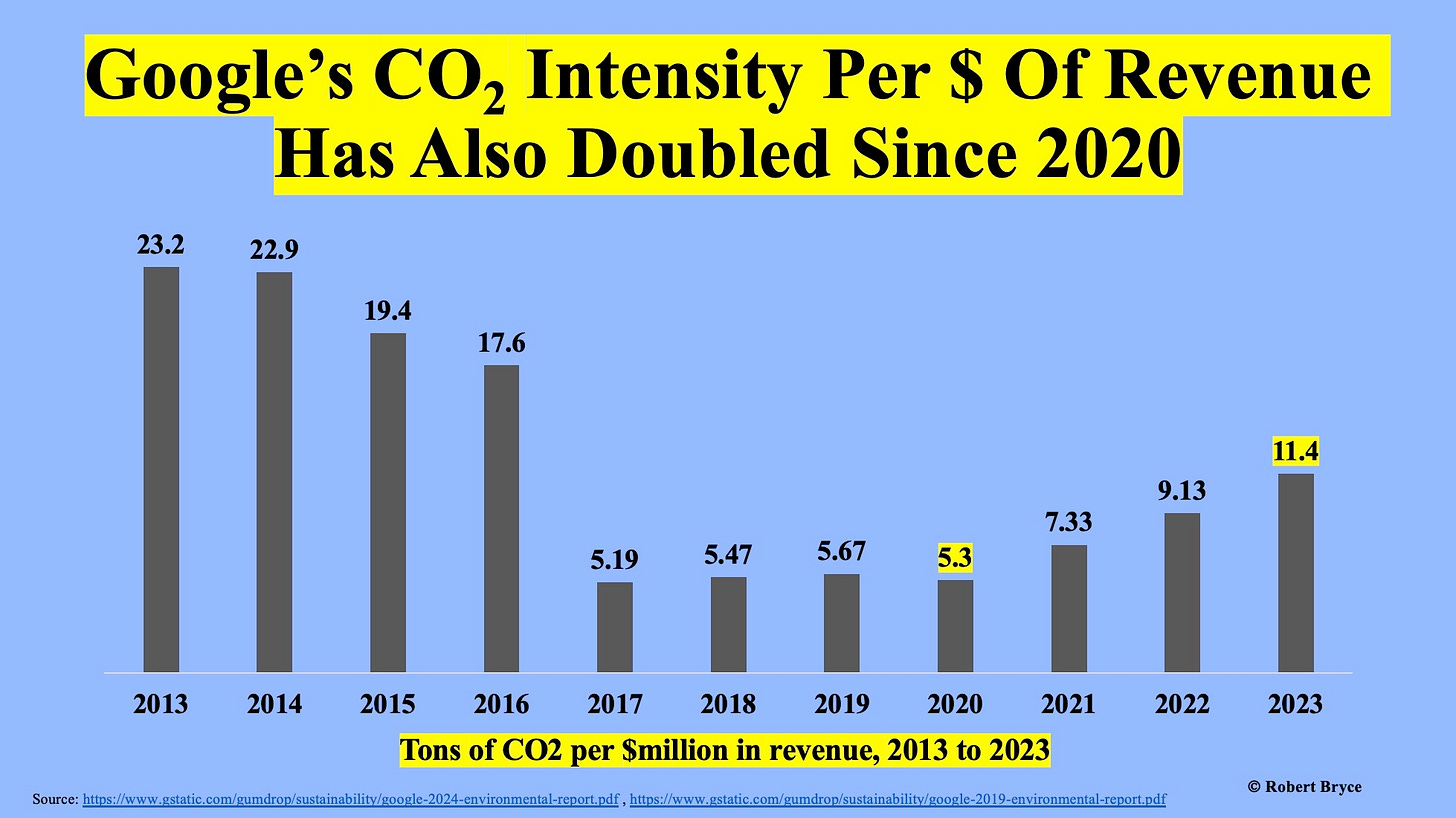Google’s Net Zero Plans Are Going Up In Smoke
For years, the search giant has touted its alt-energy deals and net zero plans. But these four charts show that Google’s electricity use, CO2 emissions, and carbon intensity, are soaring.
In 2017, Google declared it had reached “100% renewable energy for our global operations.” The company continued, “Google became carbon neutral in 2007, and since then, our carbon footprint has grown more slowly than our business — proof, 10 years later, that economic growth can be decoupled from environmental impact and resource use.”
That “decoupling” didn’t last long.
In fact, since 2017, Google’s environmental reports show that the company’s electricity use, CO2 emissions, and carbon intensity have soared. The most recent numbers came out last Tuesday when the search and advertising colossus released its 2024 environmental report. And the numbers don’t lie. As seen in the chart below, since 2017, CO2 emissions at Google have jumped four-fold to a company record of 14.3 million tons in 2023.
Why does this matter? There are many reasons. First among them: Google has been among the most aggressive promoters of the notion that it was a different kind of company, a “clean” industry from Silicon Valley that wouldn’t pollute like old industrial companies such as U.S. Steel or ExxonMobil. But the latest numbers show that Google is, at root, an industrial company that relies on massive digital foundries — that’s a better description than the anodyne “data centers” — that use staggering quantities of juice. Further, the company’s electricity needs could never be supplied by wind and solar alone. Or to put it bluntly, Google’s claims about decoupling itself from the realities of the physical world and the vagaries of electric grids were little more than corporate greenwashing.
Second, Google isn’t just a giant of Big Tech, it’s among the most dominant corporations of our era. It controls 92% of the search engine market. For comparison, Microsoft’s Bing has a 3% share. Google is the world’s most-visited website. Coming in at number two is YouTube, which is owned by Google, or rather, by the parent company, Alphabet. Thus, whether we like it or not, Google has become interwoven with our online experiences, and as shown in the chart below, those experiences have a growing carbon footprint.
What’s driving the increase? Its new report says emissions grew by 13% in 2023, “primarily driven by increased data center energy consumption and supply chain emissions.”
Third, Google has aggressively moved to squash debate over climate change on its platform, including on YouTube. In 2021, as reported by Axios, Google announced a policy that:
Prohibits climate deniers from being able to monetize their content on its platforms via ads or creator payments....It’s one of the most aggressive measures any major tech platform has taken to combat climate change misinformation...Google advertisers and publishers will be prohibited from making ad revenue off content that contradicts “well-established scientific consensus around the existence and causes of climate change.”
As the chart below shows, the CO2 intensity of Google’s operations has doubled since 2020. That’s not misinformation. Those numbers come directly from the company’s reports. (Those reports are long and challenging to read. Further, the company has not been consistent in its reporting. I used the 2024, 2021, and 2019 reports.) But don’t expect to see these trends reported by major media outlets.
Fourth, just as Google dominates search, it also dominates the stock market. If you own an index fund that tracks the S&P 500, you own Google. The company’s market cap of $2.4 trillion and surging growth make it a must-own for any exchange-traded fund that invests in growth stocks or the broader stock market. For instance, Alphabet represents about 4.3% of the stock holdings in State Street’s S&P 500 ETF (Ticker: SPY). Thus, Google’s rising greenhouse gas emissions reflect the broader economy in the U.S.
Finally, Google is signaling that it cannot achieve net zero. The company’s chief sustainability officer, Kate Brandt, told the Associated Press last week that reaching net zero by 2030 “is an extremely ambitious goal. We know this is not going to be easy and that our approach will need to continue to evolve.” (For more on that topic, see my June 3 piece, “Vaclav Smil Calls Bullshit on Net Zero.”) Brandt continued, saying the company will have to manage “a lot of uncertainty, including this uncertainty around the future of AI’s environmental impacts.”
Indeed, given the trajectory of its emissions growth and its ongoing push to build massive new data centers for AI — particularly in countries where the electric grids rely mainly on hydrocarbons — it’s safe to assume that Google’s emissions will continue climbing for years to come. In April, it announced it would spend $3 billion on new data centers in the U.S., including $2 billion in Indiana, which gets about 45% of its electricity from coal-fired power plants. Further, in its latest environmental report, the company said that although it’s making progress on “clean” energy, there are “some hard-to-decarbonize regions like Asia Pacific” where carbon-free electricity “isn’t readily available. In addition we often see longer lead times between initial investments and construction of clean energy projects and the resulting GHG reductions from them.”
Of course, Amazon and other Big Tech companies are (finally!) showing interest in nuclear energy. In March, Amazon Web Services acquired Talen Energy’s data center campus in Pennsylvania, which will allow AWS to buy as much as 480 megawatts of power from the nearby 2.5-gigawatt Susquehanna nuclear plant. But there isn’t enough nuclear capacity for all of the Big Tech companies to power their digital foundries with fission power, not here in the U.S. and certainly not in other countries.
Last week, I talked to Doug Hohulin, a Kansas City-based technologist who works on AI and closely follows the data center sector. He summed up the predicament facing Google and the other power-hungry members of Big Tech. “There’s just not enough wind and solar available,” he said. “Nuclear used to be seen as bad, and now it’s good.”
Both of those statements are true. Right now, it appears that Google and other Big Tech companies will see continuing increases in emissions until the U.S. and other countries get lots of new reactors built and online. That won’t happen quickly and it won’t be cheap. But Google’s emissions show that Big Tech doesn’t have many other choices.
Speaking Engagements In Nantucket And Newport This Week On Offshore Wind
I will be giving two lectures this week on offshore wind. On Monday, July 8, I’ll be in Nantucket speaking at the Dreamland Theater. Start time is 6 pm. Click here for tickets.
On Tuesday, the 9th, I’ll be in Newport, RI, at Emmanuel Church. The start time for that event is 5:30 pm. More info on the Newport event is available here.
If you are in the area, by all means, please attend. I will discuss the history of the offshore wind industry, the threat it poses to critically endangered North Atlantic Right Whales, and the future of American energy. Hint: It’s still N2N: natural gas to nuclear.
Before you go
As always, you will do me a favor by clicking that ♡ button, and by sharing, and subscribing. Thanks 1,000,000.







Robert,
Another informative and sobering post which exposes corporate greenwashing. The digital foundries (data centres) planned by Google and the fuller uptake of AI is going to push Google’s electricity consumption onto a much steeper upward trajectory. That electricity has to come from somewhere and replaceable energy harvesting machines (wind and solar) are simply not going to be able to provide it. It is deceptive and a misnomer for anyone to refer to “clean” or “green” electricity. All sources of electricity have a material footprint and it just so happens that wind and solar have veryyyyy large material footprints. I believe it will help us to have a better informed and more honest debate about the future of power grids if we required full Life Cycle Analyses (LCAs) of all forms of electricity generation using the International Standards Organization’s (ILO’s) Guidelines for LCAs. Such LCAs would make the material footprints, the full environmental and social impacts of each form of electricity generation much more transparent and much less liable for disingenuous language such as “clean”, “green” and “renewable”.
A very interesting lecture on the impact of digital foundries (data centres) can be accessed by typing iPres 2022 Keynote Speaker: Steven Gonzalez Monserrate. At the time Monserrate was doing research into the full impact of digital foundries (data centres).
Keep up the good work.
Douglas Jones,
retired electrical engineer.
The developed world really ought to be building way more nukes than it is. If google were serious about netzero it would be lobbying everywhere to have new nukes built. But it hasn't because most of it's netzero related stuff is virtue signalling.
Also worth noting that solar seems to have some issues scaling up as fast as some predict - https://davidturver.substack.com/p/will-silver-curb-growth-of-solar-power-pv